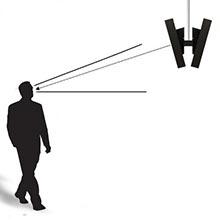Positioning Outdoor Screens for Maximum Effect
Posted by: Richard Williams | Posted on: | 0 Comments
Outdoor screens have many uses and applications. For advertisers, outdoor digital signage reaches large audiences and provides an effective and visible form of out of home marketing. For retailers and manufacturers, outdoor digital signage provides an effective method of branding, getting the company name instilled in people’s memory. And for service providers, outdoor screens provide a real-time communication platform, helping to keep customers informed of changes, schedules and timetables.
 The great advantage of outdoor digital signage is its visibility. Unlike indoor digital signage, which is now ubiquitous in shopping malls, airports, retail stores and concourses, outdoor digital signage has far less digital competition. But outdoor digital signage does have its disadvantages, unlike a screen in a doctor’s surgery or at the point of sale in a retail store, there are few opportunities for captive audiences in outdoor locations. Furthermore, while an indoor screen may enjoy a dwell time of several seconds, an audience pays less attention to outdoor screens, meaning the average dwell time for most outdoor digital signage screens is a couple of seconds at most. There are plenty of things you can do, however, to maximize the visibility of an outdoor screen and ensure as many people as possible view it.
The great advantage of outdoor digital signage is its visibility. Unlike indoor digital signage, which is now ubiquitous in shopping malls, airports, retail stores and concourses, outdoor digital signage has far less digital competition. But outdoor digital signage does have its disadvantages, unlike a screen in a doctor’s surgery or at the point of sale in a retail store, there are few opportunities for captive audiences in outdoor locations. Furthermore, while an indoor screen may enjoy a dwell time of several seconds, an audience pays less attention to outdoor screens, meaning the average dwell time for most outdoor digital signage screens is a couple of seconds at most. There are plenty of things you can do, however, to maximize the visibility of an outdoor screen and ensure as many people as possible view it.
Location
The first aspect of positioning an outdoor LCD screen is choosing the best possible location. The location may of course be restricted by other attributes such as permission, what is your property and availability of power/networking cables. However, wherever you place an outdoor screen, it should be in a location that gets as many people walking past it as possible.
Size
With outdoor digital signage, size really matters. A big difference in comparison to indoor screens is that an audience typically views outdoor screens from farther away. Not only do people view a screen as the walk towards or past it, but people also view screens from the other side of the street, or from buses, taxis and other vehicles.
Height
Height is also important. As near as possible, an outdoor screen should be no higher than eye-level. A screen too high, such as suspended from a ceiling or awning so very easily missed as people walk under it, while a screen too low may also go unnoticed. Place an outdoor screen about five feet off the ground for maximum noticeability.
Angle
An outdoor screen should also be angled towards the eye-line of an approaching audience. Rather than place a screen flush against a wall, angle it so that it is pointing directly at the oncoming audience’s eyes.
Post shortlink:
Popular Products
LCD Enclosure
Need armor for your LCD/LED screen(s)? Outdoors or inside the versatile LCD enclosure protects against thieves, vandals & the weather. Installation idea: NFL stadiums.
Outdoor Digital Signage
Exclusive 46” outdoor screen protection. Dubbed the ‘Totem’, due to its distinct design, it repels damage threats, but attracts audiences. Installation idea: Drive-thru restaurants.
Portrait Flat Panel Enclosure
Safeguard your eye-level advertising display screen(s), indoors or outdoors. Completely customizable, add exciting features like touch screen technology. Installation idea: Restaurant frontages.
Indoor Digital Signage
Popular purchase for retail outlets! Great for ‘point of sale’ persuasion, boost your brand with static & motion advertising from a single unit! Installation idea: Mall of America.




